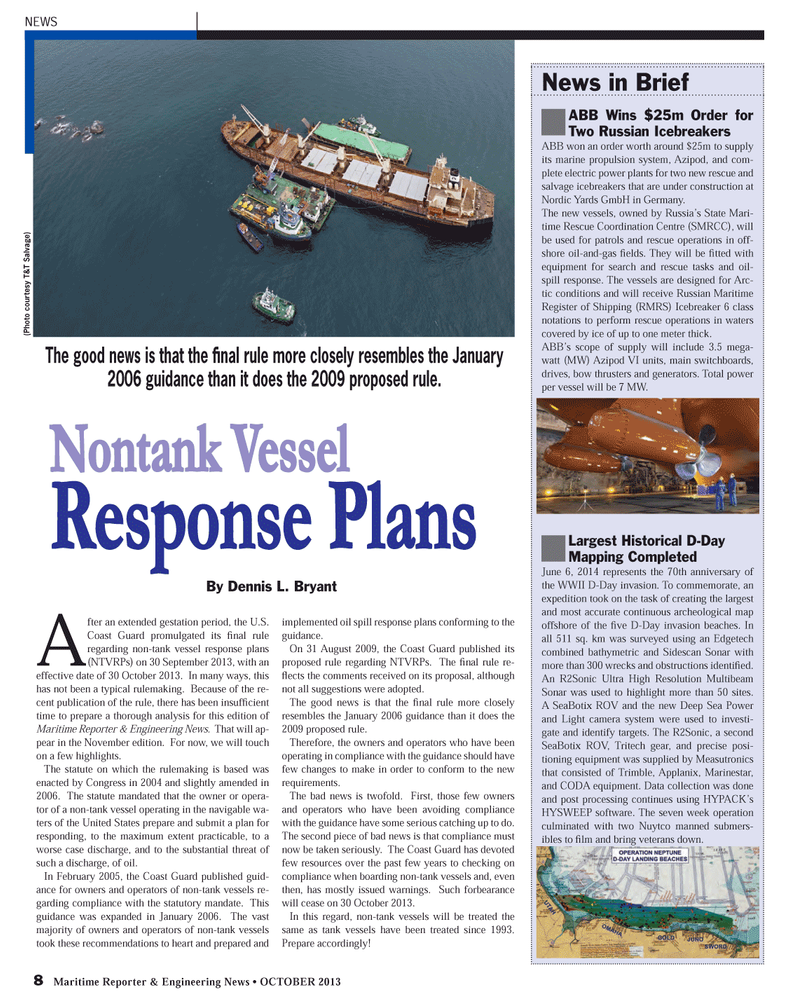
Page 8: of Maritime Reporter Magazine (October 2013)
Marine Design & Construction
Read this page in Pdf, Flash or Html5 edition of October 2013 Maritime Reporter Magazine
8 Maritime Reporter & Engineering News ? OCTOBER 2013 After an extended gestation period, the U.S. Coast Guard promulgated its Þ nal rule regarding non-tank vessel response plans (NTVRPs) on 30 September 2013, with an effective date of 30 October 2013. In many ways, this has not been a typical rulemaking. Because of the re-cent publication of the rule, there has been insufÞ cient time to prepare a thorough analysis for this edition of Maritime Reporter & Engineering News. That will ap- pear in the November edition. For now, we will touch on a few highlights.The statute on which the rulemaking is based was enacted by Congress in 2004 and slightly amended in 2006. The statute mandated that the owner or opera- tor of a non-tank vessel operating in the navigable wa-ters of the United States prepare and submit a plan for responding, to the maximum extent practicable, to a worse case discharge, and to the substantial threat of such a discharge, of oil. In February 2005, the Coast Guard published guid-ance for owners and operators of non-tank vessels re-garding compliance with the statutory mandate. This guidance was expanded in January 2006. The vast majority of owners and operators of non-tank vessels took these recommendations to heart and prepared and implemented oil spill response plans conforming to the guidance.On 31 August 2009, the Coast Guard published its proposed rule regarding NTVRPs. The Þ nal rule re- ß ects the comments received on its proposal, although not all suggestions were adopted.The good news is that the Þ nal rule more closely resembles the January 2006 guidance than it does the 2009 proposed rule. Therefore, the owners and operators who have been operating in compliance with the guidance should have few changes to make in order to conform to the new requirements. The bad news is twofold. First, those few owners and operators who have been avoiding compliance with the guidance have some serious catching up to do. The second piece of bad news is that compliance must now be taken seriously. The Coast Guard has devoted few resources over the past few years to checking on compliance when boarding non-tank vessels and, even then, has mostly issued warnings. Such forbearance will cease on 30 October 2013. In this regard, non-tank vessels will be treated the same as tank vessels have been treated since 1993. Prepare accordingly!NEWS(Photo courtesy T&T Salvage) Nontank Vessel Nontank Vessel Response Plans Response Plans News in BriefABB Wins $25m Order for Two Russian Icebreakers ABB won an order worth around $25m to supply its marine propulsion system, Azipod, and com- plete electric power plants for two new rescue and salvage icebreakers that are under construction at Nordic Yards GmbH in Germany. The new vessels, owned by Russia?s State Mari- time Rescue Coordination Centre (SMRCC), will be used for patrols and rescue operations in off- shore oil-and-gas Þ elds. They will be Þ tted with equipment for search and rescue tasks and oil-spill response. The vessels are designed for Arc- tic conditions and will receive Russian Maritime Register of Shipping (RMRS) Icebreaker 6 class notations to perform rescue operations in waters covered by ice of up to one meter thick.ABB?s scope of supply will include 3.5 mega- watt (MW) Azipod VI units, main switchboards, drives, bow thrusters and generators. Total power per vessel will be 7 MW. Largest Historical D-Day Mapping CompletedJune 6, 2014 represents the 70th anniversary of the WWII D-Day invasion. To commemorate, an expedition took on the task of creating the largest and most accurate continuous archeological map offshore of the Þ ve D-Day invasion beaches. In all 511 sq. km was surveyed using an Edgetech combined bathymetric and Sidescan Sonar with more than 300 wrecks and obstructions identiÞ ed. An R2Sonic Ultra High Resolution Multibeam Sonar was used to highlight more than 50 sites. A SeaBotix ROV and the new Deep Sea Power and Light camera system were used to investi-gate and identify targets. The R2Sonic, a second SeaBotix ROV, Tritech gear, and precise posi- tioning equipment was supplied by Measutronics that consisted of Trimble, Applanix, Marinestar, and CODA equipment. Data collection was done and post processing continues using HYPACK?s HYSWEEP software. The seven week operation culminated with two Nuytco manned submers-ibles to Þ lm and bring veterans down. By Dennis L. BryantThe good news is that the Þ nal rule more closely resembles the January 2006 guidance than it does the 2009 proposed rule. MR #10 (1-9).indd 8MR #10 (1-9).indd 810/4/2013 10:16:38 AM10/4/2013 10:16:38 AM

 7
7

 9
9
